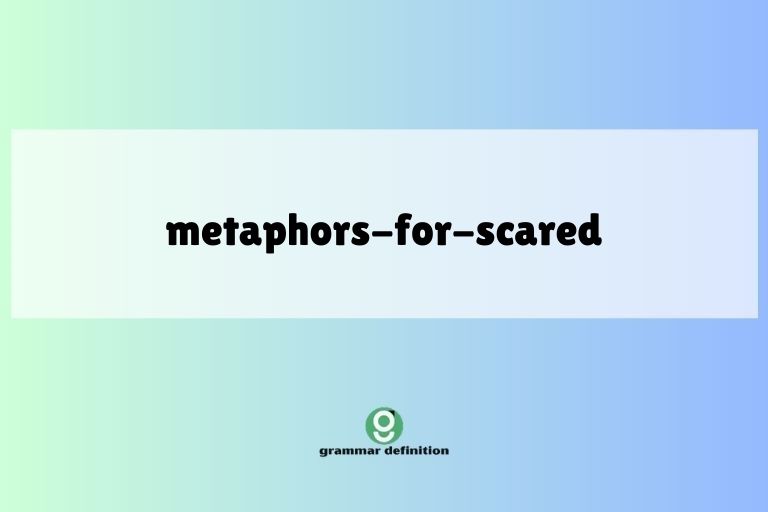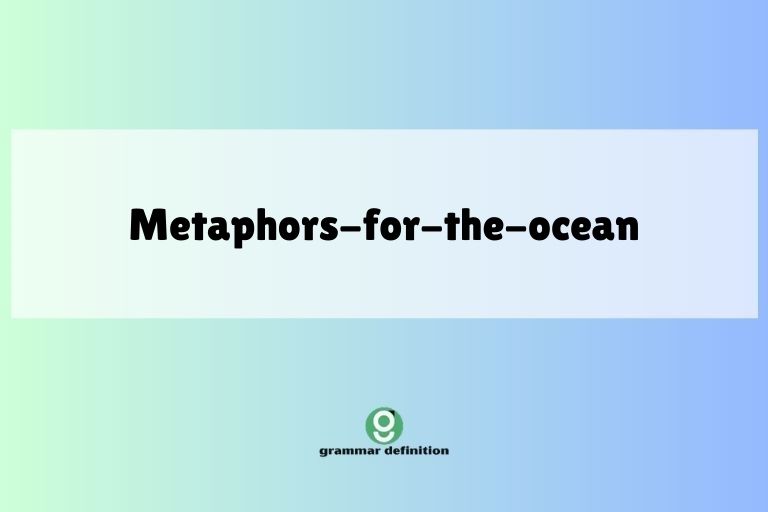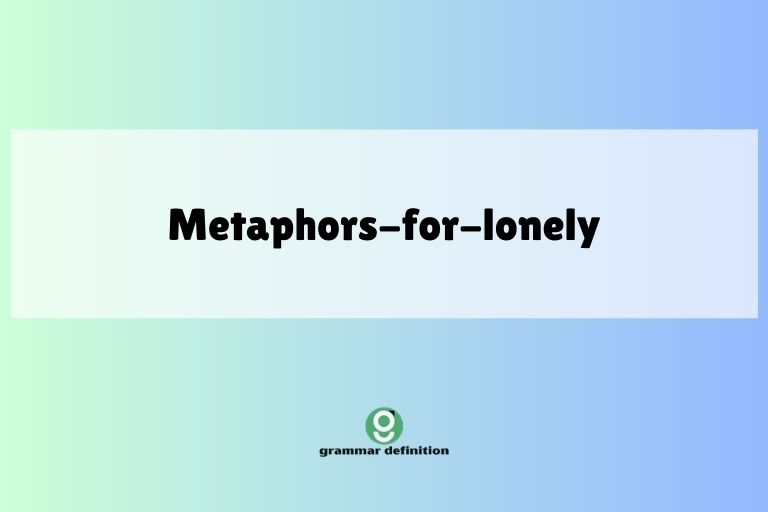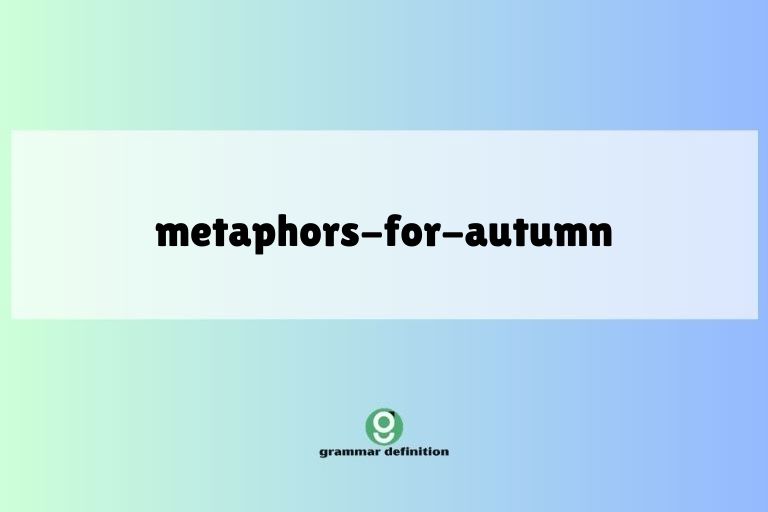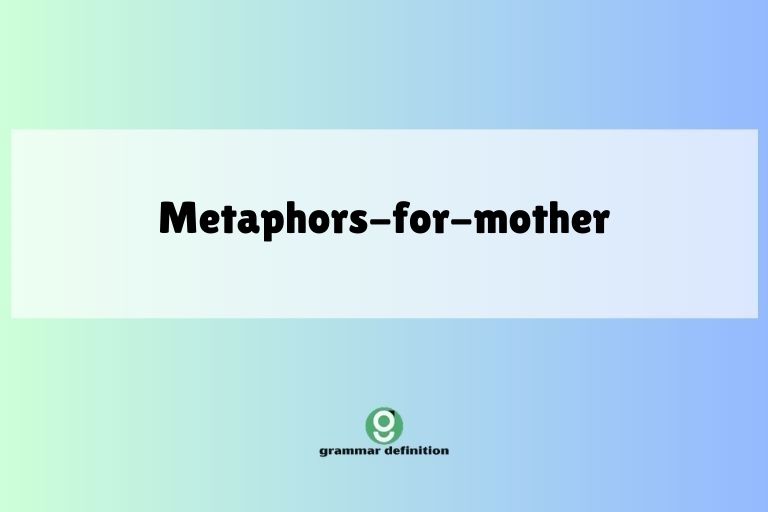Metaphors for Sleep: A Comprehensive Guide
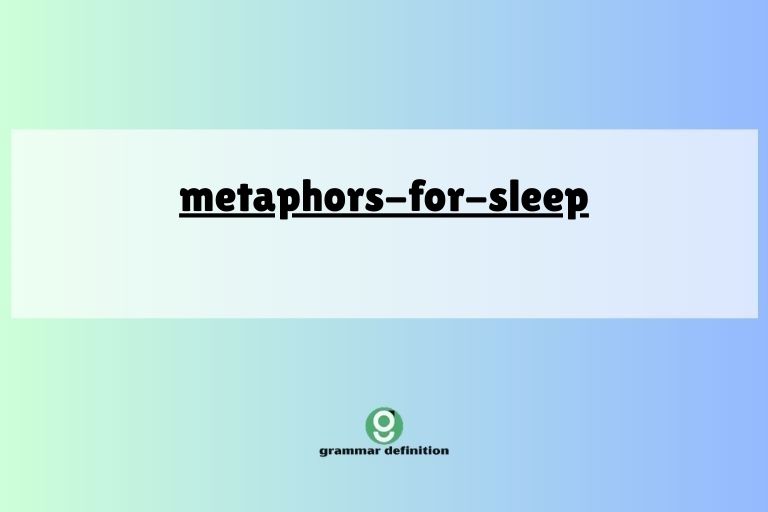
Sleep, a fundamental human need, is often described using figurative language to convey its depth and mystery. Understanding metaphors for sleep enriches our comprehension of the English language and allows us to express nuances that literal descriptions cannot capture.
This article delves into the various metaphors used to depict sleep, exploring their meanings, structures, and applications. This guide is beneficial for English language learners, writers, and anyone interested in the art of expressive communication.
Table of Contents
- Introduction
- Definition of Metaphor and Sleep
- Structural Breakdown of Sleep Metaphors
- Types of Sleep Metaphors
- Examples of Sleep Metaphors
- Usage Rules for Sleep Metaphors
- Common Mistakes When Using Sleep Metaphors
- Practice Exercises
- Advanced Topics in Sleep Metaphors
- Frequently Asked Questions
- Conclusion
Definition of Metaphor and Sleep
A metaphor is a figure of speech that directly compares two unrelated things without using “like” or “as.” It asserts that one thing is another to highlight shared qualities or create a vivid image. Metaphors are crucial for creative writing and everyday communication, enabling us to express complex ideas in a concise and impactful manner. They add depth and color to language, making it more engaging and memorable.
Sleep, in its simplest definition, is a naturally recurring state of mind and body, characterized by altered consciousness, relatively inhibited sensory activity, reduced muscle activity, and reduced interactions with surroundings. It is essential for physical and mental restoration. However, the subjective experience of sleep is far more complex, making it a fertile ground for metaphorical expression. The abstract nature of drifting into sleep and the unconscious state that follows lend themselves well to figurative language.
Structural Breakdown of Sleep Metaphors
Sleep metaphors typically involve two key components: the tenor and the vehicle. The tenor is the subject being described (in this case, sleep), and the vehicle is the concept used to describe it. The effectiveness of a sleep metaphor depends on the connection between these two elements. A strong metaphor creates a resonant link that illuminates a particular aspect of sleep.
The general structure of a sleep metaphor can be represented as: Sleep is [Vehicle]. For instance, “Sleep is a voyage” uses “voyage” as the vehicle to convey the idea of sleep as a journey. Another example is “Sleep is a balm,” where “balm” represents the restorative aspect of sleep.
The power of a metaphor lies in its ability to evoke imagery and emotion. By understanding the structural elements, we can better appreciate how metaphors transform our perception of sleep.
Consider the following examples:
- Sleep is an ocean: The vastness and depth of the ocean mirror the immersive nature of sleep.
- Sleep is a thief: This portrays sleep as something that stealthily takes away our consciousness.
- Sleep is a sculptor: This depicts sleep as a process that reshapes and restores our physical and mental state.
Types of Sleep Metaphors
Sleep metaphors can be categorized based on the specific aspect of sleep they emphasize. Here, we explore five common categories:
Sleep as a Journey
This type of metaphor portrays sleep as a voyage or expedition, emphasizing the transition from wakefulness to unconsciousness and the unknown territory of dreams. It often involves imagery of travel, exploration, and navigation.
The journey metaphor highlights the sense of leaving the familiar world behind and venturing into a different realm.
Sleep as an Escape
Here, sleep is depicted as a means of evading reality, stress, or discomfort. It offers a temporary refuge from the challenges of daily life.
These metaphors highlight the comforting and relieving aspects of sleep, where one can find solace from worries and anxieties. It can be seen as a form of mental withdrawal.
Sleep as Death or Unconsciousness
This category draws parallels between sleep and death, emphasizing the loss of consciousness and the stillness of the body. While potentially unsettling, these metaphors can also convey the profound depth and mystery of sleep.
The comparison highlights the temporary cessation of activity and awareness.
Sleep as Restoration
These metaphors focus on the rejuvenating and healing properties of sleep. Sleep is seen as a source of renewal, repairing both the body and the mind.
They often involve imagery of healing, cleansing, and revitalization. This type of metaphor underscores the essential role of sleep in maintaining overall well-being.
Sleep as Capture
In this category, sleep is personified as an entity that seizes or overcomes the individual. It highlights the irresistible and sometimes unwelcome nature of sleep, particularly when one is trying to stay awake.
This metaphor emphasizes the power and control that sleep exerts over our conscious state.
Examples of Sleep Metaphors
To illustrate the different types of sleep metaphors, we present examples in the following tables. Each table focuses on a specific category and provides a variety of metaphorical expressions.
Journey Metaphors Examples
The following table provides examples of sleep metaphors that depict sleep as a journey. These metaphors often invoke a sense of travel, exploration, and transition into an unknown realm.
| Metaphor | Explanation |
|---|---|
| Sleep is a voyage to a distant shore. | Implies a journey away from the waking world. |
| He drifted into sleep like a ship sailing into the night. | Compares falling asleep to a ship setting sail. |
| Sleep is a winding path leading to dreamland. | Suggests a journey through the subconscious. |
| She embarked on a journey to the land of Nod. | “Land of Nod” is a common euphemism for sleep. |
| Sleep is a river carrying us to unknown destinations. | Portrays sleep as a flowing current leading to new experiences. |
| He navigated the seas of sleep. | Implies active involvement in the sleep process. |
| Sleep is a train ride to tranquility. | Connects sleep with relaxation and peace. |
| She journeyed into the depths of slumber. | Emphasizes the profound nature of sleep. |
| Sleep is a flight to a world of dreams. | Associates sleep with freedom and imagination. |
| He set off on a nightly pilgrimage to the realm of sleep. | Elevates sleep to a sacred or important journey. |
| Sleep is a cosmic voyage through the constellations. | Connects sleep to the vastness and mystery of the universe. |
| She drifted along the currents of sleep. | Suggests a passive and gentle journey into sleep. |
| Sleep is a road leading to inner peace. | Portrays sleep as a pathway to emotional well-being. |
| He embarked on a quest into the dream world. | Implies an adventurous and purposeful journey into sleep. |
| Sleep is a passage to another dimension. | Connects sleep to the idea of alternate realities. |
| She sailed away on the ship of dreams. | Uses a classic image of a ship to represent the journey of sleep. |
| Sleep is a trek through the wilderness of the mind. | Suggests an exploration of the subconscious and hidden thoughts. |
| He took a nightly excursion into the realm of slumber. | Portrays sleep as a regular and enjoyable escape. |
| Sleep is a voyage into the heart of imagination. | Highlights the creative potential of sleep and dreams. |
| She rode the waves of sleep into the night. | Uses the imagery of waves to convey the feeling of drifting into sleep. |
| Sleep is a safari into the wild landscapes of the mind. | Suggests an adventurous and unpredictable journey through thoughts and emotions. |
| He navigated the labyrinth of dreams each night. | Implies a complex and intricate journey through the subconscious. |
| Sleep is a pilgrimage to the sanctuary of rest. | Elevates sleep to a sacred and restorative practice. |
| She embarked on a celestial voyage into the starry expanse of sleep. | Connects sleep to the vastness and beauty of the universe. |
Escape Metaphors Examples
This table showcases sleep metaphors that depict sleep as an escape. These metaphors emphasize the relief and comfort that sleep provides from the stresses and challenges of daily life.
| Metaphor | Explanation |
|---|---|
| Sleep is an escape from the day’s troubles. | Highlights sleep as a refuge from worries. |
| He sought refuge in the arms of sleep. | Personifies sleep as a comforting embrace. |
| Sleep is a sanctuary from the storm of reality. | Depicts sleep as a safe haven from external pressures. |
| She retreated into the peaceful realm of sleep. | Emphasizes the tranquil nature of sleep. |
| Sleep is a temporary departure from the world’s demands. | Portrays sleep as a break from responsibilities. |
| He found solace in the quiet embrace of sleep. | Connects sleep with comfort and emotional relief. |
| Sleep is a vacation from consciousness. | Compares sleep to a relaxing getaway. |
| She escaped into the oblivion of sleep. | Highlights the sense of detachment from reality. |
| Sleep is a shield against the arrows of stress. | Depicts sleep as a protective barrier. |
| He absconded into the land of dreams. | Suggests a secretive and liberating escape. |
| Sleep is a hideaway from the world’s noise. | Portrays sleep as a quiet and peaceful retreat. |
| She sought asylum in the depths of sleep. | Implies that sleep offers protection from mental or emotional distress. |
| Sleep is a liberation from the chains of wakefulness. | Connects sleep to freedom and release. |
| He retreated to the fortress of sleep. | Depicts sleep as a secure and impenetrable refuge. |
| Sleep is a sanctuary where worries cannot reach. | Emphasizes the protective and comforting nature of sleep. |
| She escaped to the island of slumber. | Uses the image of an island to represent a secluded and peaceful escape. |
| Sleep is a refuge from the battlefield of the day. | Portrays daily life as a struggle and sleep as a safe haven. |
| He found respite in the arms of Morpheus. | Refers to Morpheus, the Greek god of dreams, implying a divine escape. |
| Sleep is a haven where troubles fade away. | Suggests that sleep offers a comforting and healing environment. |
| She sought solace in the embrace of nighttime’s quiet arms. | Personifies nighttime and connects it with comfort and peace. |
| Sleep is a temporary reprieve from the demands of existence. | Highlights the break that sleep provides from the pressures of life. |
| He escaped the clutches of reality through the door of sleep. | Implies that sleep is a portal to a different, more desirable state. |
| Sleep is a sanctuary where the mind finds peace and the body finds rest. | Emphasizes the dual restorative benefits of sleep for both mind and body. |
| She retreated into the silent, sheltering arms of sleep. | Personifies sleep as a protective and comforting presence. |
Death Metaphors Examples
The following table provides examples of sleep metaphors that draw parallels between sleep and death. These metaphors emphasize the loss of consciousness and the stillness of the body, highlighting the profound depth and mystery of sleep.
| Metaphor | Explanation |
|---|---|
| Sleep is a little death. | Compares the unconsciousness of sleep to death. |
| He surrendered to the embrace of oblivion. | Implies a complete loss of awareness. |
| Sleep is a temporary cessation of being. | Highlights the temporary pause in activity. |
| She drifted into the silent void of sleep. | Emphasizes the emptiness and stillness of sleep. |
| Sleep is a brief encounter with nothingness. | Portrays sleep as a temporary state of non-existence. |
| He entered the kingdom of shadows. | Connects sleep with darkness and mystery. |
| Sleep is a rehearsal for the final curtain call. | Draws a dramatic parallel with death. |
| She succumbed to the lure of eternal rest. | Implies a surrender to a state of deep unconsciousness. |
| Sleep is a journey into the land of the dead. | Uses a vivid image to convey the depth of sleep. |
| He crossed the threshold into the realm of slumber. | Highlights the transition from wakefulness to sleep. |
| Sleep is a descent into the underworld of the mind. | Connects sleep to the hidden and mysterious aspects of consciousness. |
| She vanished into the still, dark waters of sleep. | Uses the imagery of water to represent the deep and unknown nature of sleep. |
| Sleep is a brief taste of the afterlife. | Suggests that sleep gives a glimpse into a state beyond human experience. |
| He faded into the eternal night of sleep. | Portrays sleep as a dark and unending expanse. |
| Sleep is a temporary farewell to the world. | Emphasizes the detachment from reality that sleep provides. |
| She slipped into the silent embrace of the grave of sleep. | Uses strong imagery to convey the depth and stillness of sleep. |
| Sleep is a preview of the great unknown. | Suggests that sleep offers a glimpse into the mysteries of existence. |
| He journeyed into the land where all memories cease. | Implies a complete loss of awareness and recollection during sleep. |
| Sleep is a momentary glimpse beyond the veil. | Connects sleep to the idea of hidden or unseen realms. |
| She entered the quiet kingdom where time has no meaning. | Portrays sleep as a realm outside of the constraints of time. |
| Sleep is a brief plunge into the abyss of unconsciousness. | Highlights the depth and mystery of the unconscious state. |
| He surrendered to the dark, silent waters of sleep. | Uses the imagery of water to represent the unknown and potentially overwhelming nature of sleep. |
| Sleep is a temporary journey to the other side. | Suggests that sleep allows us to cross into a different realm of experience. |
| She drifted into the silent, starless sea of sleep. | Uses the imagery of the sea to convey the vastness and mystery of sleep. |
Restoration Metaphors Examples
This table showcases sleep metaphors that focus on the rejuvenating and healing properties of sleep. These metaphors emphasize the renewal and repair that sleep provides for both the body and the mind.
| Metaphor | Explanation |
|---|---|
| Sleep is a balm for the weary soul. | Connects sleep with healing and comfort. |
| He recharged his batteries with a night’s sleep. | Compares sleep to replenishing energy. |
| Sleep is a fountain of youth. | Associates sleep with rejuvenation. |
| She healed her wounds in the sanctuary of sleep. | Emphasizes the restorative power of sleep. |
| Sleep is a reset button for the mind. | Portrays sleep as a way to clear mental clutter. |
| He found renewal in the embrace of slumber. | Connects sleep with revitalization. |
| Sleep is a spa treatment for the brain. | Compares sleep to a luxurious and restorative experience. |
| She revitalized her spirit through the gift of sleep. | Highlights the positive impact of sleep on well-being. |
| Sleep is a gardener tending to the flowers of the mind. | Suggests that sleep nurtures and cares for mental health. |
| He mended his body with the stitches of sleep. | Uses a vivid image to convey the healing power of sleep. |
| Sleep is an elixir for the weary traveler. | Portrays sleep as a potion that restores energy and vitality. |
| She refreshed her soul in the quiet waters of sleep. | Uses the imagery of water to represent cleansing and renewal. |
| Sleep is a mechanic fine-tuning the engine of the body. | Connects sleep to the maintenance and repair of physical health. |
| He restored his strength with the rejuvenating power of sleep. | Emphasizes the ability of sleep to rebuild physical and mental energy. |
| Sleep is a painter retouching the canvas of the mind. | Suggests that sleep renews and refreshes thoughts and perceptions. |
| She found solace and healing in the tranquil arms of sleep. | Personifies sleep as a comforting and restorative presence. |
| Sleep is a sanctuary where the body rebuilds and the mind unwinds. | Highlights the dual restorative benefits of sleep for both physical and mental health. |
| He rejuvenated his senses with the quiet balm of sleep. | Uses the imagery of balm to convey the soothing and healing properties of sleep. |
| Sleep is a restorative oasis in the desert of daily life. | Portrays sleep as a place of refuge and renewal amidst the challenges of daily existence. |
| She allowed sleep to wash away the day’s fatigue and restore her inner harmony. | Uses the imagery of washing to represent the cleansing and restorative power of sleep. |
| Sleep is a sculptor reshaping the weary body into a vessel of vitality. | Suggests that sleep actively works to rebuild and revitalize the physical form. |
| He sought refuge in the healing embrace of sleep, where wounds both seen and unseen could begin to mend. | Emphasizes the holistic healing power of sleep, addressing both physical and emotional wounds. |
| Sleep is the silent gardener tending to the delicate blooms of the mind, nurturing creativity and insight. | Portrays sleep as a caretaker of mental health, fostering creativity and clarity. |
| She surrendered to the restorative embrace of sleep, allowing its gentle currents to carry away the burdens of the day. | Uses the imagery of water to represent the soothing and cleansing power of sleep. |
Capture Metaphors Examples
In this category, sleep is personified as an entity that seizes or overcomes the individual. It highlights the irresistible and sometimes unwelcome nature of sleep, particularly when one is trying to stay awake.
| Metaphor | Explanation |
|---|---|
| Sleep claimed him in its gentle grasp. | Personifies sleep as an entity that takes hold. |
| She was swallowed by the depths of slumber. | Emphasizes the immersive nature of sleep. |
| Sleep overtook him like a rising tide. | Compares sleep to an overwhelming force. |
| He succumbed to the siren call of sleep. | Portrays sleep as an alluring and irresistible force. |
| Sleep ensnared her in its silken web. | Uses the image of a web to represent the captivating nature of sleep. |
| He was ambushed by the shadows of sleep. | Implies a sudden and unexpected onset of sleep. |
| Sleep seized her with its irresistible power. | Highlights the strength and control of sleep. |
| He was engulfed by the waves of slumber. | Uses the imagery of waves to represent the overwhelming nature of sleep. |
| Sleep conquered him, despite his best efforts. | Portrays sleep as a victor in a battle against wakefulness. |
| She was captured by the alluring arms of sleep. | Personifies sleep as a captivating entity. |
| Sleep enveloped him in its velvet cloak. | Uses the imagery of a cloak to represent the comforting and encompassing nature of sleep. |
| She was drawn into the irresistible vortex of sleep. | Portrays sleep as a powerful and inescapable force. |
| Sleep descended upon him like a gentle predator. | Connects sleep to the idea of being hunted or pursued. |
| He was overcome by the seductive embrace of slumber. | Personifies sleep as a tempting and irresistible presence. |
| Sleep wrapped its tendrils around her, pulling her into darkness. | Uses the imagery of tendrils to represent the grasping and enveloping nature of sleep. |
| He was lured into the deep, dark ocean of sleep. | Portrays sleep as a vast and mysterious realm that captivates and consumes. |
| Sleep crept up on her like a silent thief, stealing her consciousness away. | Connects sleep to the idea of being robbed or deprived of awareness. |
| He was ensnared in the hypnotic spell of sleep, unable to resist its pull. | Implies that sleep has a magical and irresistible power over the individual. |
| Sleep seized control of her senses, plunging her into a world of dreams and shadows. | Highlights the loss of control and the shift into a different state of consciousness. |
| He was ambushed by the relentless tide of sleep, surrendering to its inexorable current. | Portrays sleep as a powerful and unstoppable force that cannot be resisted. |
| Sleep ensnared her in its labyrinthine embrace, leading her through a maze of dreams and visions. | Uses the imagery of a labyrinth to represent the complex and disorienting nature of sleep. |
| He was overcome by the seductive whispers of sleep, promising respite and escape from the waking world. | Personifies sleep as a tempting and alluring voice that lures the individual into unconsciousness. |
| Sleep seized him in its powerful grip, transporting him to a realm where reality and imagination intertwined. | Highlights the transformative power of sleep and its ability to transport the individual to a different state of being. |
| She was captured by the velvet tendrils of sleep, gently pulled into a world of dreams and forgotten memories. | Uses the imagery of velvet tendrils to represent the soft and comforting nature of sleep. |
Usage Rules for Sleep Metaphors
Using metaphors effectively requires careful consideration of context and audience. Here are some guidelines to ensure your sleep metaphors are impactful and appropriate:
- Clarity: Ensure the connection between the tenor (sleep) and the vehicle (the metaphorical element) is clear. Avoid overly obscure or convoluted metaphors that may confuse the reader.
- Relevance: Choose metaphors that align with the overall tone and theme of your writing. A metaphor comparing sleep to death might be unsuitable in a lighthearted context.
- Originality: While common metaphors can be effective, strive for originality to make your writing stand out. Consider fresh and unexpected comparisons that offer new insights into the nature of sleep.
- Consistency: Maintain consistency in your metaphorical language. Avoid mixing metaphors or abruptly switching between different types of imagery.
- Audience: Consider your audience’s understanding and background. A metaphor that resonates with one audience may not be effective with another.
Common Mistakes When Using Sleep Metaphors
Here are some common mistakes to avoid when using sleep metaphors:
| Mistake | Incorrect Example | Correct Example |
|---|---|---|
| Mixed Metaphor: Combining incompatible metaphorical elements. | Sleep is a river of rest that sharpens the mind like a sword. | Sleep is a river of rest that soothes the weary soul. |
| Clichéd Metaphor: Using overused and predictable metaphors. | Sleep is a dream. | Sleep is a silent symphony. |
| Inappropriate Tone: Using metaphors that clash with the overall tone. | Sleep is a battlefield where nightmares wage war. (In a children’s bedtime story) | Sleep is a peaceful garden where dreams blossom. (In a children’s bedtime story) |
| Lack of Clarity: Using metaphors that are too abstract or obscure. | Sleep is a chromatic abstraction. | Sleep is a canvas painted with dreams. |
Practice Exercises
Test your understanding of sleep metaphors with the following exercises:
-
Exercise 1: Identify the Type of Metaphor
For each sentence, identify the type of sleep metaphor used (Journey, Escape, Death/Unconsciousness, Restoration, Capture).
Sentence Type of Metaphor 1. Sleep is a balm for the tired mind. 2. He embarked on a voyage to the land of Nod. 3. Sleep claimed her in its gentle embrace. 4. She sought refuge in the arms of sleep. 5. Sleep is a little death. 6. He recharged his batteries with a good night’s rest. 7. She retreated to the peaceful realm of sleep. 8. Sleep overtook him like a rising tide. 9. Sleep is a train ride to tranquility. 10. He surrendered to the embrace of oblivion. Answers:
Sentence Type of Metaphor 1. Sleep is a balm for the tired mind. Restoration 2. He embarked on a voyage to the land of Nod. Journey 3. Sleep claimed her in its gentle embrace. Capture 4. She sought refuge in the arms of sleep. Escape 5. Sleep is a little death. Death/Unconsciousness 6. He recharged his batteries with a good night’s rest. Restoration 7. She retreated to the peaceful realm of sleep. Escape 8. Sleep overtook him like a rising tide. Capture 9. Sleep is a train ride to tranquility. Journey 10. He surrendered to the embrace of oblivion. Death/Unconsciousness -
Exercise 2: Complete the Metaphor
Complete the following sentences by adding a suitable metaphor for sleep.
Sentence Completion 1. After a long day, sleep is like __________. 2. When stress overwhelms, sleep is __________. 3. For a weary traveler, sleep is __________. 4. To a tired mind, sleep is __________. 5. The transition to sleep is like __________. 6. Sleep is __________ that heals all wounds. 7. To the exhausted body, sleep is __________. 8. Sleep is __________ where dreams take flight. 9. For the overworked soul, sleep is __________. 10. Sleep is __________ that washes away the day’s troubles. Possible Answers:
Sentence Completion 1. After a long day, sleep is like a warm embrace. 2. When stress overwhelms, sleep is a peaceful escape. 3. For a weary traveler, sleep is a rejuvenating oasis. 4. To a tired mind, sleep is a silent retreat. 5. The transition to sleep is like drifting down a gentle stream. 6. Sleep is a soothing balm that heals all wounds. 7. To the exhausted body, sleep is a revitalizing tonic. 8. Sleep is a magical realm where dreams take flight. 9. For the overworked soul, sleep is a necessary respite. 10. Sleep is a cleansing rain that washes away the day’s troubles.
Advanced Topics in Sleep Metaphors
For advanced learners, exploring the cultural and historical contexts of sleep metaphors
is highly beneficial. Different cultures may have unique interpretations and associations with sleep, which are reflected in their metaphorical expressions.
For example, some cultures view sleep as a sacred state, while others see it as a vulnerable one. Examining these variations can provide deeper insights into the cultural values and beliefs surrounding sleep.
Additionally, consider the use of sleep metaphors in literature and art. Many writers and artists have employed sleep metaphors to explore themes of mortality, consciousness, and the human condition.
Analyzing these works can offer a richer understanding of the metaphorical potential of sleep. Further study could include:
- The evolution of sleep metaphors over time.
- The use of sleep metaphors in different genres (e.g., poetry, prose, drama).
- The psychological impact of sleep metaphors on readers and listeners.
- Cross-cultural comparisons of sleep metaphors.
Frequently Asked Questions
- Q: Why are metaphors useful when describing sleep?
- A: Metaphors help to convey the complex and subjective experience of sleep in a more vivid and relatable way. They allow us to express nuances that literal descriptions cannot capture.
- Q: Can sleep metaphors be used in scientific writing?
- A: While scientific writing typically emphasizes precise and literal language, metaphors can be used sparingly to illustrate complex concepts or engage the reader. However, it’s important to maintain clarity and avoid ambiguity.
- Q: How can I create my own original sleep metaphors?
- A: Start by identifying the specific aspect of sleep you want to emphasize (e.g., its restorative power, its mysterious nature). Then, brainstorm unrelated concepts that share similar qualities. Experiment with different comparisons until you find a metaphor that resonates with you.
- Q: Are there any negative connotations associated with sleep metaphors?
- A: Some sleep metaphors, such as those comparing sleep to death or capture, can have negative connotations. It’s important to be mindful of these associations and choose metaphors that align with your intended message.
- Q: How do dreams relate to sleep metaphors?
- A: Dreams often serve as a source of inspiration for sleep metaphors, as they represent the imaginative and surreal aspects of sleep. Metaphors can be used to describe the nature of dreams themselves, such as “Dreams are fleeting visions” or “Dreams are echoes of the past.”
Conclusion
Metaphors for sleep offer a rich and diverse landscape for exploring the complexities of this fundamental human experience. By understanding the different types of sleep metaphors, their structural elements, and their cultural contexts, we can enhance our ability to communicate effectively and appreciate the art of figurative language.
Whether you are a writer, a language learner, or simply someone interested in the power of words, mastering the use of sleep metaphors can enrich your understanding and expression of the English language. Embrace the creativity and insight that metaphors provide, and unlock new ways of perceiving the world around you, one dream at a time.

